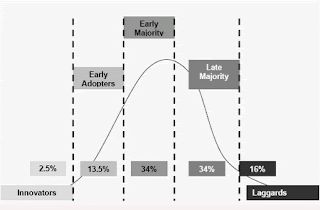

Presenting and facilitating at four very different events recently, inside and outside of the field of Diplomacy*, I heard similar things from people who are only now feeling their way into how they can engage with the online mainstream:
- there are many from the ‘early majority’: people who have became enthusiastic and skilled users of several social media or collaborative platforms and who want to integrate them into their everyday work, as well as evaluate some of the less-well known tools
- there are probably more from the ‘late majority’ who are involved in one or two platforms, sometimes uneasily or by default:
- ‘I am on Facebook to follow the kids‘ is something I’ve heard around the world;
- the logistics information, agenda and reports for two of the workshops were on a wiki, which for many of the participants was their first real exposure to anything other than Wikipedia: they had no choice;
- ‘I kept being invited to LinkedIn so I eventually joined’
- and there are some classic late adopters checking out the space: ‘everyone tells me I need to be on Twitter, do I?’ (to which the answer is, ‘it depends’. I don’t like the term ‘laggards’ in the diagram above. It is loaded and inaccurate: it implies everyone will – should – adopt, eventually. But there is, of course, no reason to join any of these platforms unless it serves a purpose).
Eight principles for those late into the social web
- As ever, start with your aims: why would you want to use one of these tools? For example:
- Promotion: what is the audience you want to reach, where do they hangout online? Research, join and start to engage.
- Collaboration: are your colleagues already using a tool? How good is their Internet access and how confident are they using social media? Select an appropriate platform (see below) and invest the time in learning how to use it well, so you can support them. Note that if you choose a wiki they will probably find it surprisingly difficult.
- Engage with people: the essence of social media is that it is, well, social. That means personal conversations, linking people to people, sharing information, ideas etc, joining important lists and conversations on other people’s sites. These are not platforms for broadcast messages. Crucially, it also means keeping on top of the exchanges, for example, commenting on comments, thanking people for linking to your work or RT your tweets.
- Feed the web and it will feed you back. Contribute content, however little (think of it as your entry fee); browse around and find what you like, and then tell people – share: link to other people’s content, RT in Twitter, like in Facebook or slideshare and comment in blogs. This will get you noticed, connected and – if your content has meaning – shared in turn
- Use groups of tools, linking and integrating: many social media tools are designed to do one thing well but they are all designed to interact and exchange data (to be mashed up, as they say). For example, I echo tweets into LinkedIn (via the Hootsuite client) and selectively into Facebook (you simply have to link the two accounts and use #fb). I tweet about content I generate – Blogs, videos, photos, slides;
- Always share and record your work online somewhere public, for example slides on slideshare, project progress on Blogs or Twitter
- Monitor and adapt: learn how to measure your progress and periodically test whether you are getting any kind of return on your investment of time and energy. RoI is of course the central decider for organisational investment in social media but it is as important for individuals**. And of course it’s not simply about quantitative measures: while number of followers or views is important, especially over time, it’s as if not more important to identify and record conversations – the essence of the social web. Are you meeting new people or deepening existing relationships? Are you getting access to new resources? Are you developing a network of connections that appreciate what you do, tell you so and provide useful content or contacts in return? If not, well dump the platform.
- Be yourself: authenticity scores over slickness, although manufacturing ‘authenticity’ earns PR firms and political spin merchants a good living.
- Have fun: Good social media practice has a lot in common with being a good party host: introduce people to people, provide interesting titbits, circulate regularly, help people have fun.
So what social media tools do you use?
- Twitter – via client software – I use hootsuite, a web client, – or tweetdeck, which has a downloadable client
- Delicious: it’s always surprising how few people who work collaboratively with others around the world use Delicious or one of the competitors like Diigo
- Dropbox: probably the most straightforward collaborative application since it requires no social media experience and, carefully managed, can serve as a common repository for collaborative projects. Importantly, it doesn’t require users to change their favourite tools, like MS Office or the Mac equivalents
- Wiki: (e.g. euforicweb😉 platforms I use include mediawiki [free, open source: clunky, the original, and still the Wikipedia platform]; wikispaces; pbworks. Note that a lot of people find learning to use a wiki quite difficult: for example the ‘edit’ function, also a basic essential for blogging, flummoxes people who haven’t had a lot of experience
- Google docs: this is what Diplo uses and tends to be easier to understand for new users than wikis since the applications ‘feel’ similar to MS Office packages that people use already. It does require good Internet access, although there is offline access to documents. Candidly, I have had more problems that I expected with offline Google docs
- News and other feeds, through Google Reader; we use netvibes as an introduction to the value of filtering news through feeds since it also allows users to share and publish a common home page, as in this great example from Diplo’s Stephanie Psaila
- Blogs, as here. I always quote John Naughton as my favourite blogger, partly for interest and partly because he does it so well; Tim Davies is another superb digital-artist***.
- Slideshare
- Scheduling tools: for example Doodle for diaries; eventbrite for, er, events
- YouTube: Diplo also uses Blip.tv, as it syndicates content to other sites; Vimeo is used by many people for video quality reasons
- Flickr for pictures and images: many people also Google’s platform called Picassa. Diplo uses Smugmug which, like Flickr, generates code to embed easily photos and slides in blogs or other web platforms.
- Mindmeister, for collaborative mindmaps
- Yammer, which works as an internal Twitter
- Tumblr, an easy to use and flexible blogging and aggregation tool
- Google+, Google’s ‘social network’, which is apparently used by more people than Twitter, but still has to convince me
- Pinterest which enables people to collect and link to images from across the web and I communicate best through images
Notes:
* the eDiplomacy day at the Instituto Publico in Rome, an ICARDA/ICRISAT programme inception workshop in Dubai, an informal chat with a group of international development consultants in Oxford and a social media training workshop at the UN FAO in Rome
** Each platform has internal reporting tools, basic or richer, and for the popular platforms there are hosts of add-ons. For the more thorough, interested in overall statistics and trends, Google Analytics is easy to learn and connect to your sites.
*** Disclosure – Tim has worked with Diplo at IGF and other events


